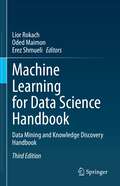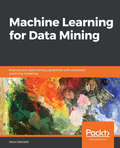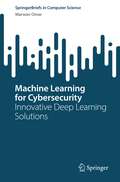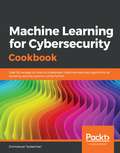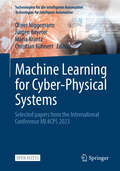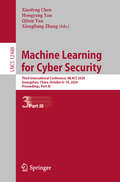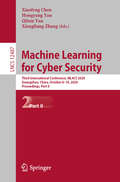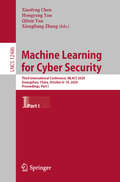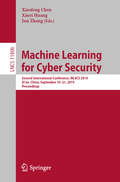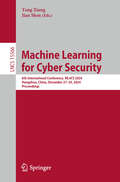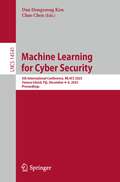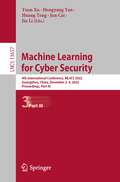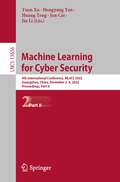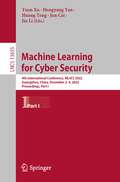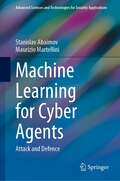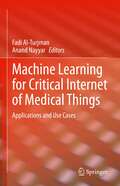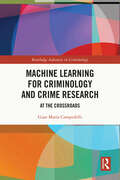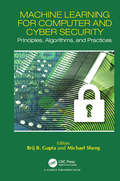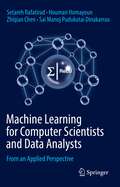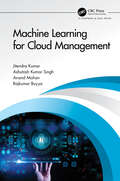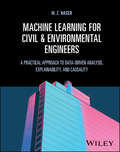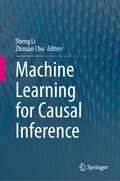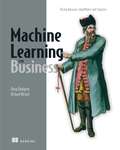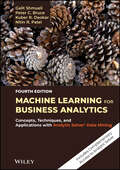- Table View
- List View
Machine Learning for Data Science Handbook: Data Mining and Knowledge Discovery Handbook
by Lior Rokach Oded Maimon Erez ShmueliThis book organizes key concepts, theories, standards, methodologies, trends, challenges and applications of data mining and knowledge discovery in databases. It first surveys, then provides comprehensive yet concise algorithmic descriptions of methods, including classic methods plus the extensions and novel methods developed recently. It also gives in-depth descriptions of data mining applications in various interdisciplinary industries.
Machine Learning for Data Mining: Improve your data mining capabilities with advanced predictive modeling
by Jesus SalcedoGet efficient in performing data mining and machine learning using IBM SPSS Modeler Key FeaturesLearn how to apply machine learning techniques in the field of data scienceUnderstand when to use different data mining techniques, how to set up different analyses, and how to interpret the resultsA step-by-step approach to improving model development and performanceBook DescriptionMachine learning (ML) combined with data mining can give you amazing results in your data mining work by empowering you with several ways to look at data. This book will help you improve your data mining techniques by using smart modeling techniques.This book will teach you how to implement ML algorithms and techniques in your data mining work. It will enable you to pair the best algorithms with the right tools and processes. You will learn how to identify patterns and make predictions with minimal human intervention. You will build different types of ML models, such as the neural network, the Support Vector Machines (SVMs), and the Decision tree. You will see how all of these models works and what kind of data in the dataset they are suited for. You will learn how to combine the results of different models in order to improve accuracy. Topics such as removing noise and handling errors will give you an added edge in model building and optimization.By the end of this book, you will be able to build predictive models and extract information of interest from the datasetWhat you will learnHone your model-building skills and create the most accurate modelsUnderstand how predictive machine learning models workPrepare your data to acquire the best possible resultsCombine models in order to suit the requirements of different types of dataAnalyze single and multiple models and understand their combined resultsDerive worthwhile insights from your data using histograms and graphsWho this book is forIf you are a data scientist, data analyst, and data mining professional and are keen to achieve a 30% higher salary by adding machine learning to your skillset, then this is the ideal book for you. You will learn to apply machine learning techniques to various data mining challenges. No prior knowledge of machine learning is assumed.
Machine Learning for Cybersecurity: Innovative Deep Learning Solutions (SpringerBriefs in Computer Science)
by Marwan OmarThis SpringerBrief presents the underlying principles of machine learning and how to deploy various deep learning tools and techniques to tackle and solve certain challenges facing the cybersecurity industry.By implementing innovative deep learning solutions, cybersecurity researchers, students and practitioners can analyze patterns and learn how to prevent cyber-attacks and respond to changing malware behavior. The knowledge and tools introduced in this brief can also assist cybersecurity teams to become more proactive in preventing threats and responding to active attacks in real time. It can reduce the amount of time spent on routine tasks and enable organizations to use their resources more strategically. In short, the knowledge and techniques provided in this brief can help make cybersecurity simpler, more proactive, less expensive and far more effectiveAdvanced-level students in computer science studying machine learning with a cybersecurity focus will find this SpringerBrief useful as a study guide. Researchers and cybersecurity professionals focusing on the application of machine learning tools and techniques to the cybersecurity domain will also want to purchase this SpringerBrief.
Machine Learning for Cybersecurity Cookbook: Over 80 recipes on how to implement machine learning algorithms for building security systems using Python
by Emmanuel TsukermanLearn how to apply modern AI to create powerful cybersecurity solutions for malware, pentesting, social engineering, data privacy, and intrusion detection Key Features Manage data of varying complexity to protect your system using the Python ecosystem Apply ML to pentesting, malware, data privacy, intrusion detection system(IDS) and social engineering Automate your daily workflow by addressing various security challenges using the recipes covered in the book Book Description Organizations today face a major threat in terms of cybersecurity, from malicious URLs to credential reuse, and having robust security systems can make all the difference. With this book, you'll learn how to use Python libraries such as TensorFlow and scikit-learn to implement the latest artificial intelligence (AI) techniques and handle challenges faced by cybersecurity researchers. You'll begin by exploring various machine learning (ML) techniques and tips for setting up a secure lab environment. Next, you'll implement key ML algorithms such as clustering, gradient boosting, random forest, and XGBoost. The book will guide you through constructing classifiers and features for malware, which you'll train and test on real samples. As you progress, you'll build self-learning, reliant systems to handle cybersecurity tasks such as identifying malicious URLs, spam email detection, intrusion detection, network protection, and tracking user and process behavior. Later, you'll apply generative adversarial networks (GANs) and autoencoders to advanced security tasks. Finally, you'll delve into secure and private AI to protect the privacy rights of consumers using your ML models. By the end of this book, you'll have the skills you need to tackle real-world problems faced in the cybersecurity domain using a recipe-based approach. What you will learn Learn how to build malware classifiers to detect suspicious activities Apply ML to generate custom malware to pentest your security Use ML algorithms with complex datasets to implement cybersecurity concepts Create neural networks to identify fake videos and images Secure your organization from one of the most popular threats – insider threats Defend against zero-day threats by constructing an anomaly detection system Detect web vulnerabilities effectively by combining Metasploit and ML Understand how to train a model without exposing the training data Who this book is for This book is for cybersecurity professionals and security researchers who are looking to implement the latest machine learning techniques to boost computer security, and gain insights into securing an organization using red and blue team ML. This recipe-based book will also be useful for data scientists and machine learning developers who want to experiment with smart techniques in the cybersecurity domain. Working knowledge of Python programming and familiarity with cybersecurity fundamentals will help you get the most out of this book.
Machine Learning for Cyber-Physical Systems: Selected papers from the International Conference ML4CPS 2023 (Technologien für die intelligente Automation #18)
by Jürgen Beyerer Oliver Niggemann Christian Kühnert Maria KrantzThis open access proceedings presents new approaches to Machine Learning for Cyber-Physical Systems, experiences and visions. It contains some selected papers from the international Conference ML4CPS – Machine Learning for Cyber-Physical Systems, which was held in Hamburg (Germany), March 29th to 31st, 2023. Cyber-physical systems are characterized by their ability to adapt and to learn: They analyze their environment and, based on observations, they learn patterns, correlations and predictive models. Typical applications are condition monitoring, predictive maintenance, image processing and diagnosis. Machine Learning is the key technology for these developments.This is an open access book.
Machine Learning for Cyber Security: Third International Conference, ML4CS 2020, Guangzhou, China, October 8–10, 2020, Proceedings, Part III (Lecture Notes in Computer Science #12488)
by Xiangliang Zhang Xiaofeng Chen Hongyang Yan Qiben YanThis three volume book set constitutes the proceedings of the Third International Conference on Machine Learning for Cyber Security, ML4CS 2020, held in Xi’an, China in October 2020.The 118 full papers and 40 short papers presented were carefully reviewed and selected from 360 submissions. The papers offer a wide range of the following subjects: Machine learning, security, privacy-preserving, cyber security, Adversarial machine Learning, Malware detection and analysis, Data mining, and Artificial Intelligence.
Machine Learning for Cyber Security: Third International Conference, ML4CS 2020, Guangzhou, China, October 8–10, 2020, Proceedings, Part II (Lecture Notes in Computer Science #12487)
by Xiangliang Zhang Xiaofeng Chen Hongyang Yan Qiben YanThis three volume book set constitutes the proceedings of the Third International Conference on Machine Learning for Cyber Security, ML4CS 2020, held in Xi’an, China in October 2020.The 118 full papers and 40 short papers presented were carefully reviewed and selected from 360 submissions. The papers offer a wide range of the following subjects: Machine learning, security, privacy-preserving, cyber security, Adversarial machine Learning, Malware detection and analysis, Data mining, and Artificial Intelligence.
Machine Learning for Cyber Security: Third International Conference, ML4CS 2020, Guangzhou, China, October 8–10, 2020, Proceedings, Part I (Lecture Notes in Computer Science #12486)
by Xiangliang Zhang Xiaofeng Chen Hongyang Yan Qiben YanThis three volume book set constitutes the proceedings of the Third International Conference on Machine Learning for Cyber Security, ML4CS 2020, held in Xi’an, China in October 2020.The 118 full papers and 40 short papers presented were carefully reviewed and selected from 360 submissions. The papers offer a wide range of the following subjects: Machine learning, security, privacy-preserving, cyber security, Adversarial machine Learning, Malware detection and analysis, Data mining, and Artificial Intelligence.
Machine Learning for Cyber Security: Second International Conference, ML4CS 2019, Xi’an, China, September 19-21, 2019, Proceedings (Lecture Notes in Computer Science #11806)
by Jun Zhang Xinyi Huang Xiaofeng ChenThis book constitutes the proceedings of the Second International Conference on Machine Learning for Cyber Security, ML4CS 2019, held in Xi’an, China in September 2019. The 23 revised full papers and 3 short papers presented were carefully reviewed and selected from 70 submissions. The papers detail all aspects of machine learning in network infrastructure security, in network security detections and in application software security.
Machine Learning for Cyber Security: 6th International Conference, ML4CS 2024, Hangzhou, China, December 27–29, 2024, Proceedings (Lecture Notes in Computer Science #15566)
by Yang Xiang Jian ShenThis book constitutes the referred proceedings of the 6th International Conference on Machine Learning for Cyber Security, ML4CS 2024, held in Hangzhou, China, during December 27–29, 2024. The 30 full papers presented in this book were carefully reviewed and selected from 111 submissions. ML4CS is a well-recognized annual international forum for AI-driven security researchers to exchange ideas and present their works. The conference focus on topics such as blockchain, network security, system security, software security, threat intelligence, cybersecurity situational awareness and much many more.
Machine Learning for Cyber Security: 5th International Conference, ML4CS 2023, Yanuca Island, Fiji, December 4–6, 2023, Proceedings (Lecture Notes in Computer Science #14541)
by Chao Chen Dan Dongseong KimThis book constitutes the referred proceedings of the 5th International Conference on Machine Learning for Cyber Security, ML4CS 2023, held in Yanuca Island, Fiji, during December 4–6, 2023. The 11 full papers presented in this book were carefully reviewed and selected from 35 submissions. They cover a variety of topics, including cybersecurity, AI security, machine learning security, encryption, authentication, data security and privacy, cybersecurity forensic analysis, vulnerability analysis, malware analysis, anomaly and intrusion detection.
Machine Learning for Cyber Security: 4th International Conference, ML4CS 2022, Guangzhou, China, December 2–4, 2022, Proceedings, Part III (Lecture Notes in Computer Science #13657)
by Jin Li Yuan Xu Jun Cai Hongyang Yan Huang TengThe three-volume proceedings set LNCS 13655,13656 and 13657 constitutes the refereedproceedings of the 4th International Conference on Machine Learning for Cyber Security, ML4CS 2022, which taking place during December 2–4, 2022, held in Guangzhou, China.The 100 full papers and 46 short papers were included in these proceedings were carefully reviewed and selected from 367 submissions.
Machine Learning for Cyber Security: 4th International Conference, ML4CS 2022, Guangzhou, China, December 2–4, 2022, Proceedings, Part II (Lecture Notes in Computer Science #13656)
by Jin Li Yuan Xu Jun Cai Hongyang Yan Huang TengThe three-volume proceedings set LNCS 13655,13656 and 13657 constitutes the refereedproceedings of the 4th International Conference on Machine Learning for Cyber Security, ML4CS 2022, which taking place during December 2–4, 2022, held in Guangzhou, China. The 100 full papers and 46 short papers were included in these proceedings were carefully reviewed and selected from 367 submissions.
Machine Learning for Cyber Security: 4th International Conference, ML4CS 2022, Guangzhou, China, December 2–4, 2022, Proceedings, Part I (Lecture Notes in Computer Science #13655)
by Jin Li Yuan Xu Jun Cai Hongyang Yan Huang TengThe three-volume proceedings set LNCS 13655,13656 and 13657 constitutes the refereedproceedings of the 4th International Conference on Machine Learning for Cyber Security, ML4CS 2022, which taking place during December 2–4, 2022, held in Guangzhou, China.The 100 full papers and 46 short papers were included in these proceedings were carefully reviewed and selected from 367 submissions.
Machine Learning for Cyber Physical System: Advances and Challenges (Intelligent Systems Reference Library #60)
by Margarita Favorskaya Janmenjoy Nayak Bighnaraj Naik Vimal S.This book provides a comprehensive platform for learning the state-of-the-art machine learning algorithms for solving several cybersecurity issues. It is helpful in guiding for the implementation of smart machine learning solutions to detect various cybersecurity problems and make the users to understand in combating malware, detect spam, and fight financial fraud to mitigate cybercrimes. With an effective analysis of cyber-physical data, it consists of the solution for many real-life problems such as anomaly detection, IoT-based framework for security and control, manufacturing control system, fault detection, smart cities, risk assessment of cyber-physical systems, medical diagnosis, smart grid systems, biometric-based physical and cybersecurity systems using advance machine learning approach. Filling an important gap between machine learning and cybersecurity communities, it discusses topics covering a wide range of modern and practical advance machine learning techniques, frameworks, and development tools to enable readers to engage with the cutting-edge research across various aspects of cybersecurity.
Machine Learning for Cyber Agents: Attack and Defence (Advanced Sciences and Technologies for Security Applications)
by Maurizio Martellini Stanislav AbaimovThe cyber world has been both enhanced and endangered by AI. On the one hand, the performance of many existing security services has been improved, and new tools created. On the other, it entails new cyber threats both through evolved attacking capacities and through its own imperfections and vulnerabilities. Moreover, quantum computers are further pushing the boundaries of what is possible, by making machine learning cyber agents faster and smarter. With the abundance of often-confusing information and lack of trust in the diverse applications of AI-based technologies, it is essential to have a book that can explain, from a cyber security standpoint, why and at what stage the emerging, powerful technology of machine learning can and should be mistrusted, and how to benefit from it while avoiding potentially disastrous consequences. In addition, this book sheds light on another highly sensitive area – the application of machine learning for offensive purposes, an aspect that is widely misunderstood, under-represented in the academic literature and requires immediate expert attention.
Machine Learning for Critical Internet of Medical Things: Applications and Use Cases
by Fadi Al-Turjman Anand NayyarThis book discusses the applications, challenges, and future trends of machine learning in medical domain, including both basic and advanced topics. The book presents how machine learning is helpful in smooth conduction of administrative processes in hospitals, in treating infectious diseases, and in personalized medical treatments. The authors show how machine learning can also help make fast and more accurate disease diagnoses, easily identify patients, help in new types of therapies or treatments, model small-molecule drugs in pharmaceutical sector, and help with innovations via integrated technologies such as artificial intelligence as well as deep learning. The authors show how machine learning also improves the physician’s and doctor’s medical capabilities to better diagnosis their patients. This book illustrates advanced, innovative techniques, frameworks, concepts, and methodologies of machine learning that will enhance the efficiency and effectiveness of the healthcare system.Provides researchers in machine and deep learning with a conceptual understanding of various methodologies of implementing the technologies in medical areas;Discusses the role machine learning and IoT play into locating different virus and diseases across the globe, such as COVID-19, Ebola, and cervical cancer;Includes fundamentals and advances in machine learning in the medical field, supported by significant case studies and practical applications.
Machine Learning for Criminology and Crime Research: At the Crossroads (Routledge Advances in Criminology)
by Gian Maria CampedelliMachine Learning for Criminology and Crime Research: At the Crossroads reviews the roots of the intersection between machine learning, artificial intelligence (AI), and research on crime; examines the current state of the art in this area of scholarly inquiry; and discusses future perspectives that may emerge from this relationship. As machine learning and AI approaches become increasingly pervasive, it is critical for criminology and crime research to reflect on the ways in which these paradigms could reshape the study of crime. In response, this book seeks to stimulate this discussion. The opening part is framed through a historical lens, with the first chapter dedicated to the origins of the relationship between AI and research on crime, refuting the "novelty narrative" that often surrounds this debate. The second presents a compact overview of the history of AI, further providing a nontechnical primer on machine learning. The following chapter reviews some of the most important trends in computational criminology and quantitatively characterizing publication patterns at the intersection of AI and criminology, through a network science approach. This book also looks to the future, proposing two goals and four pathways to increase the positive societal impact of algorithmic systems in research on crime. The sixth chapter provides a survey of the methods emerging from the integration of machine learning and causal inference, showcasing their promise for answering a range of critical questions. With its transdisciplinary approach, Machine Learning for Criminology and Crime Research is important reading for scholars and students in criminology, criminal justice, sociology, and economics, as well as AI, data sciences and statistics, and computer science.
Machine Learning for Computer and Cyber Security: Principle, Algorithms, and Practices (Cyber Ecosystem And Security Ser.)
by Quan Z. Sheng Brij B. GuptaWhile Computer Security is a broader term which incorporates technologies, protocols, standards and policies to ensure the security of the computing systems including the computer hardware, software and the information stored in it, Cyber Security is a specific, growing field to protect computer networks (offline and online) from unauthorized access, botnets, phishing scams, etc. Machine learning is a branch of Computer Science which enables computing machines to adopt new behaviors on the basis of observable and verifiable data and information. It can be applied to ensure the security of the computers and the information by detecting anomalies using data mining and other such techniques. <P><P>This book will be an invaluable resource to understand the importance of machine learning and data mining in establishing computer and cyber security. It emphasizes important security aspects associated with computer and cyber security along with the analysis of machine learning and data mining based solutions. The book also highlights the future research domains in which these solutions can be applied. Furthermore, it caters to the needs of IT professionals, researchers, faculty members, scientists, graduate students, research scholars and software developers who seek to carry out research and develop combating solutions in the area of cyber security using machine learning based approaches. It is an extensive source of information for the readers belonging to the field of Computer Science and Engineering, and Cyber Security professionals. <P><P>Key Features: <li>This book contains examples and illustrations to demonstrate the principles, algorithms, challenges and applications of machine learning and data mining for computer and cyber security. <li>It showcases important security aspects and current trends in the field. <li>It provides an insight of the future research directions in the field. <P><P>Contents of this book help to prepare the students for exercising better defense in terms of understanding the motivation of the attackers and how to deal with and mitigate the situation using machine learning based approaches in better manner.
Machine Learning for Computer Scientists and Data Analysts: From an Applied Perspective
by Setareh Rafatirad Houman Homayoun Zhiqian Chen Sai Manoj Pudukotai DinakarraoThis textbook introduces readers to the theoretical aspects of machine learning (ML) algorithms, starting from simple neuron basics, through complex neural networks, including generative adversarial neural networks and graph convolution networks. Most importantly, this book helps readers to understand the concepts of ML algorithms and enables them to develop the skills necessary to choose an apt ML algorithm for a problem they wish to solve. In addition, this book includes numerous case studies, ranging from simple time-series forecasting to object recognition and recommender systems using massive databases. Lastly, this book also provides practical implementation examples and assignments for the readers to practice and improve their programming capabilities for the ML applications.
Machine Learning for Cloud Management
by Rajkumar Buyya Jitendra Kumar Anand Mohan Ashutosh Kumar SinghCloud computing offers subscription-based on-demand services, and it has emerged as the backbone of the computing industry. It has enabled us to share resources among multiple users through virtualization, which creates a virtual instance of a computer system running in an abstracted hardware layer. Unlike early distributed computing models, it offers virtually limitless computing resources through its large scale cloud data centers. It has gained wide popularity over the past few years, with an ever-increasing infrastructure, a number of users, and the amount of hosted data. The large and complex workloads hosted on these data centers introduce many challenges, including resource utilization, power consumption, scalability, and operational cost. Therefore, an effective resource management scheme is essential to achieve operational efficiency with improved elasticity. Machine learning enabled solutions are the best fit to address these issues as they can analyze and learn from the data. Moreover, it brings automation to the solutions, which is an essential factor in dealing with large distributed systems in the cloud paradigm. Machine Learning for Cloud Management explores cloud resource management through predictive modelling and virtual machine placement. The predictive approaches are developed using regression-based time series analysis and neural network models. The neural network-based models are primarily trained using evolutionary algorithms, and efficient virtual machine placement schemes are developed using multi-objective genetic algorithms. Key Features: the first book to set out a range of machine learning methods for efficient resource management in a large distributed network of clouds. predictive analytics is an integral part of efficient cloud resource management, and this book gives a future research direction to researchers in this domain. it is written by leading international researchers. The book is ideal for researchers who are working in the domain of cloud computing.
Machine Learning for Civil and Environmental Engineers: A Practical Approach to Data-Driven Analysis, Explainability, and Causality
by M. Z. NaserAccessible and practical framework for machine learning applications and solutions for civil and environmental engineers This textbook introduces engineers and engineering students to the applications of artificial intelligence (AI), machine learning (ML), and machine intelligence (MI) in relation to civil and environmental engineering projects and problems, presenting state-of-the-art methodologies and techniques to develop and implement algorithms in the engineering domain. Through real-world projects like analysis and design of structural members, optimizing concrete mixtures for site applications, examining concrete cracking via computer vision, evaluating the response of bridges to hazards, and predicating water quality and energy expenditure in buildings, this textbook offers readers in-depth case studies with solved problems that are commonly faced by civil and environmental engineers. The approaches presented range from simplified to advanced methods, incorporating coding-based and coding-free techniques. Professional engineers and engineering students will find value in the step-by-step examples that are accompanied by sample databases and codes for readers to practice with. Written by a highly qualified professional with significant experience in the field, Machine Learning includes valuable information on: The current state of machine learning and causality in civil and environmental engineering as viewed through a scientometrics analysis, plus a historical perspective Supervised vs. unsupervised learning for regression, classification, and clustering problems Explainable and causal methods for practical engineering problems Database development, outlining how an engineer can effectively collect and verify appropriate data to be used in machine intelligence analysis A framework for machine learning adoption and application, covering key questions commonly faced by practitioners This textbook is a must-have reference for undergraduate/graduate students to learn concepts on the use of machine learning, for scientists/researchers to learn how to integrate machine learning into civil and environmental engineering, and for design/engineering professionals as a reference guide for undertaking MI design, simulation, and optimization for infrastructure.
Machine Learning for Causal Inference
by Sheng Li Zhixuan ChuThis book provides a deep understanding of the relationship between machine learning and causal inference. It covers a broad range of topics, starting with the preliminary foundations of causal inference, which include basic definitions, illustrative examples, and assumptions. It then delves into the different types of classical causal inference methods, such as matching, weighting, tree-based models, and more. Additionally, the book explores how machine learning can be used for causal effect estimation based on representation learning and graph learning. The contribution of causal inference in creating trustworthy machine learning systems to accomplish diversity, non-discrimination and fairness, transparency and explainability, generalization and robustness, and more is also discussed. The book also provides practical applications of causal inference in various domains such as natural language processing, recommender systems, computer vision, time series forecasting, and continual learning. Each chapter of the book is written by leading researchers in their respective fields. Machine Learning for Causal Inference explores the challenges associated with the relationship between machine learning and causal inference, such as biased estimates of causal effects, untrustworthy models, and complicated applications in other artificial intelligence domains. However, it also presents potential solutions to these issues. The book is a valuable resource for researchers, teachers, practitioners, and students interested in these fields. It provides insights into how combining machine learning and causal inference can improve the system's capability to accomplish causal artificial intelligence based on data. The book showcases promising research directions and emphasizes the importance of understanding the causal relationship to construct different machine-learning models from data.
Machine Learning for Business: Using Amazon SageMaker and Jupyter
by Doug Hudgeon Richard NicholSummary Imagine predicting which customers are thinking about switching to a competitor or flagging potential process failures before they happen Think about the benefits of forecasting tedious business processes and back-office tasks Envision quickly gauging customer sentiment from social media content (even large volumes of it). Consider the competitive advantage of making decisions when you know the most likely future events Machine learning can deliver these and other advantages to your business, and it&’s never been easier to get started! Purchase of the print book includes a free eBook in PDF, Kindle, and ePub formats from Manning Publications. About the technology Machine learning can deliver huge benefits for everyday business tasks. With some guidance, you can get those big wins yourself without complex math or highly paid consultants! If you can crunch numbers in Excel, you can use modern ML services to efficiently direct marketing dollars, identify and keep your best customers, and optimize back office processes. This book shows you how. About the book Machine Learning for Business teaches business-oriented machine learning techniques you can do yourself. Concentrating on practical topics like customer retention, forecasting, and back office processes, you&’ll work through six projects that help you form an ML-for-business mindset. To guarantee your success, you&’ll use the Amazon SageMaker ML service, which makes it a snap to turn your questions into results. What's inside Identifying tasks suited to machine learning Automating back office processes Using open source and cloud-based tools Relevant case studies About the reader For technically inclined business professionals or business application developers. About the author Doug Hudgeon and Richard Nichol specialize in maximizing the value of business data through AI and machine learning for companies of any size. Table of Contents: PART 1 MACHINE LEARNING FOR BUSINESS 1 ¦ How machine learning applies to your business PART 2 SIX SCENARIOS: MACHINE LEARNING FOR BUSINESS 2 ¦ Should you send a purchase order to a technical approver? 3 ¦ Should you call a customer because they are at risk of churning? 4 ¦ Should an incident be escalated to your support team? 5 ¦ Should you question an invoice sent by a supplier? 6 ¦ Forecasting your company&’s monthly power usage 7 ¦ Improving your company&’s monthly power usage forecast PART 3 MOVING MACHINE LEARNING INTO PRODUCTION 8 ¦ Serving predictions over the web 9 ¦ Case studies
Machine Learning for Business Analytics: Concepts, Techniques, and Applications with Analytic Solver Data Mining
by Galit Shmueli Peter C. Bruce Nitin R. Patel Kuber R. DeokarMACHINE LEARNING FOR BUSINESS ANALYTICS Machine learning—also known as data mining or predictive analytics—is a fundamental part of data science. It is used by organizations in a wide variety of arenas to turn raw data into actionable information. Machine Learning for Business Analytics: Concepts, Techniques, and Applications with Analytic Solver® Data Mining provides a comprehensive introduction and an overview of this methodology. The fourth edition of this best-selling textbook covers both statistical and machine learning algorithms for prediction, classification, visualization, dimension reduction, rule mining, recommendations, clustering, text mining, experimentation, time series forecasting and network analytics. Along with hands-on exercises and real-life case studies, it also discusses managerial and ethical issues for responsible use of machine learning techniques. This fourth edition of Machine Learning for Business Analytics also includes: An expanded chapter on deep learning A new chapter on experimental feedback techniques, including A/B testing, uplift modeling, and reinforcement learning A new chapter on responsible data science Updates and new material based on feedback from instructors teaching MBA, Masters in Business Analytics and related programs, undergraduate, diploma and executive courses, and from their students A full chapter devoted to relevant case studies with more than a dozen cases demonstrating applications for the machine learning techniques End-of-chapter exercises that help readers gauge and expand their comprehension and competency of the material presented A companion website with more than two dozen data sets, and instructor materials including exercise solutions, slides, and case solutions This textbook is an ideal resource for upper-level undergraduate and graduate level courses in data science, predictive analytics, and business analytics. It is also an excellent reference for analysts, researchers, and data science practitioners working with quantitative data in management, finance, marketing, operations management, information systems, computer science, and information technology.
